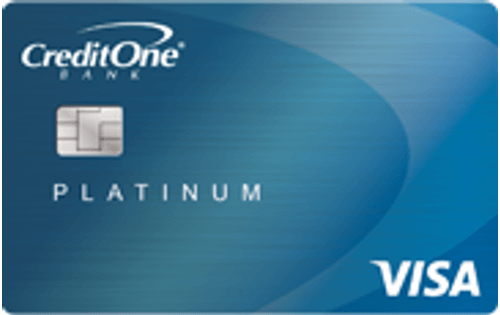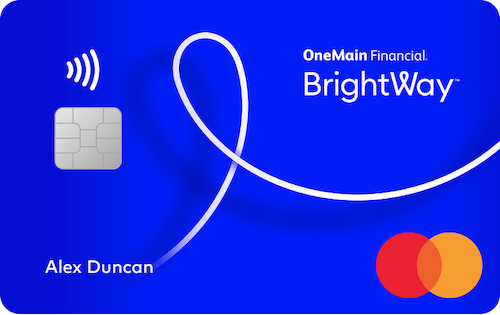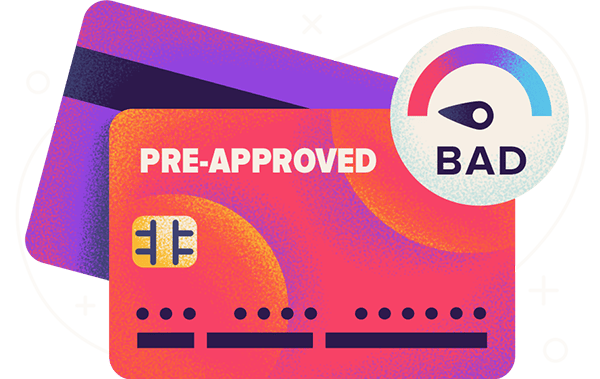- Best pre-approved credit cards for bad credit compared
- Methodology
- Sources
- About the author
- User questions & answers
Best Pre-Approved Credit Cards for Bad Credit Compared
| Credit Card | Best For | Annual Fee | Pre-Qualification |
| Credit One Bank® Platinum Visa® for Rebuilding Credit | Gas & Groceries | $75 intro 1st yr, $99 after | Check online |
| Destiny Mastercard® Cashback Rewards | Flat Rewards Rate | $175 intro 1st yr, $49 after | Check online |
| Aspire® Cash Back Rewards Mastercard | Cash Back | $85-$175 1st yr, $49 after | Check online |
| Fortiva® Cash Back Rewards Mastercard | Bonus Rewards | $85-$175 1st yr, $49 after | Check online |
| opensky® Plus Secured Visa® Credit Card | No Credit Check | $0 | Check online |
| Credit One Bank® Secured Card | Secured Card with Rewards | $0 | Check online |
The issuers of these cards also mail pre-approved offers to eligible applicants. If you receive a pre-approved offer and apply using the code provided in the mailing, your odds of approval will be very high.
In addition, it’s important to point out that even though you cannot pre-qualify for most secured credit cards, you should still be able to get approved no matter how damaged your credit may be. In fact, several secured cards won’t even check your credit when you apply, so there’s no hard pull and no temporary credit score damage. There’s really no point in offering pre-qualification when the approval requirements are so low.
Methodology for Selecting the Best Pre-Approved Credit Cards for Bad Credit
 To identify the best pre-approved credit cards for bad credit, WalletHub’s editors compare all of the credit cards available to people with bad credit from our database of 1,500+ offers.
To identify the best pre-approved credit cards for bad credit, WalletHub’s editors compare all of the credit cards available to people with bad credit from our database of 1,500+ offers.After filtering out cards for which consumers cannot check their pre-qualification status online as well as cards from issuers that don’t regularly send pre-approved offers to consumers, we compare the remaining offers based on fees, rewards, interest rates, security-deposit requirements, approval requirements, and other WalletHub Rating components. We then select the options that project to save consumers the most money over a span of two years.
How Two-Year Cost Is Calculated
Two-year cost is used to approximate the monetary value of cards for better comparison and is calculated by combining annual and monthly membership fees over two years, adding any one-time fees or other fees (like balance transfer fees), adding any interest costs, and subtracting rewards. Negative amounts indicate savings. When fees or other terms are presented as a range, we use the midpoint for scoring purposes.
Rewards bonuses and credits have been taken into account for two-year cost calculations. However, bonuses applicable to only a very small portion of cardholders are not considered. For example, credits and bonuses awarded for spending or redeeming rewards through a company portal with non-co-branded cards have not been taken into account. Similarly, bonuses and credits related to spending with specific merchants using a non-co-branded card have not been taken into account (for example, if Card A offers credits with DoorDash, this feature would not be factored into calculations because it is hard to assess how many cardholders would use the benefit or exactly how much value they'd get from it).
Cardholder Spending Profiles
Given that people have differing goals and are likely to use their credit cards differently, we identified spending profiles that are representative of users’ varied financial priorities and behaviors. For each cardholder type, we have assumed a specific amount of monthly spending by purchase type (e.g., groceries, gas, etc.), as well as an average balance, balance transfer amount, amount spent on large purchases and average monthly payment. Spending assumptions are based on Bureau of Labor Statistics data.
Sources
WalletHub actively maintains a database of 1,500+ credit card offers, from which we select the best credit cards for bad credit for different applicants as well as derive market-wide takeaways and trends. The underlying data is compiled from credit card company websites or provided directly by the credit card issuers. We also leverage data from the Bureau of Labor Statistics to develop cardholder profiles, used to estimate cards’ potential savings.
(see https://angular.dev/best-practices/security#preventing-cross-site-scripting-xss)








